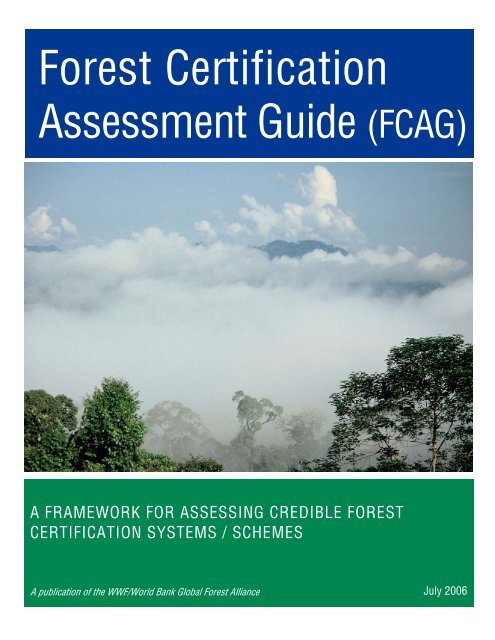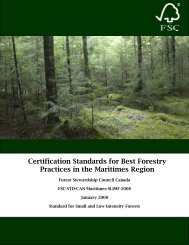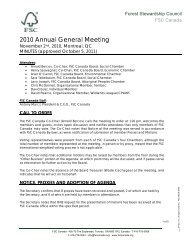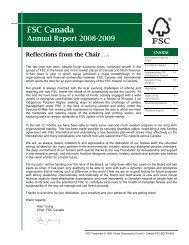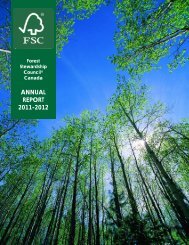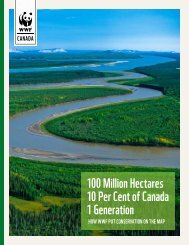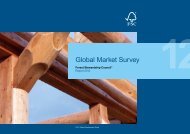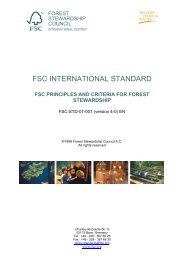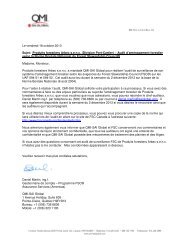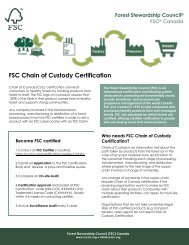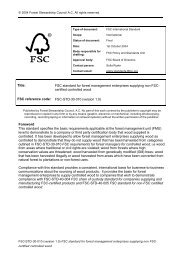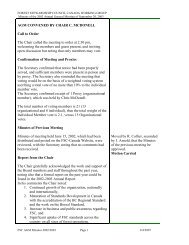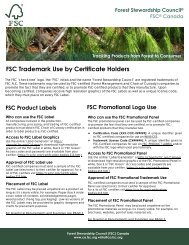WWF/World Bank Forest Certification Assessment Guide
WWF/World Bank Forest Certification Assessment Guide
WWF/World Bank Forest Certification Assessment Guide
- No tags were found...
Create successful ePaper yourself
Turn your PDF publications into a flip-book with our unique Google optimized e-Paper software.
<strong>Forest</strong> <strong>Certification</strong><strong>Assessment</strong> <strong>Guide</strong> (FCAG)A FRAMEWORK FOR ASSESSING CREDIBLE FORESTCERTIFICATION SYSTEMS / SCHEMESA publication of the <strong>WWF</strong>/<strong>World</strong> <strong>Bank</strong> Global <strong>Forest</strong> Alliance July 2006
ForewordThe <strong>WWF</strong>/<strong>World</strong> <strong>Bank</strong> Alliance for <strong>Forest</strong> Conservation & Sustainable Use (theAlliance, now known as the Global <strong>Forest</strong> Alliance) was created in 1997. The partners— <strong>WWF</strong> and the <strong>World</strong> <strong>Bank</strong> — set a target of achieving 200 million hectares ofproduction forests under independently certified sustainable management, and to framethis work produced a set of criteria that certification systems should meet. These weresubsequently encapsulated within the revised <strong>World</strong> <strong>Bank</strong> <strong>Forest</strong> Policy in 2004. Bothpartners have undertaken a variety of work to promote this target — the <strong>World</strong> <strong>Bank</strong>through its country and project level lending, and <strong>WWF</strong> through its work with thecorporate sector (including the work of the Global <strong>Forest</strong> & Trade Network).Staff within both organizations faced two challenges. First, a variety of forestcertification systems exist. A common and systematic framework for <strong>WWF</strong> and<strong>World</strong> <strong>Bank</strong> managers was therefore needed to evaluate the different systems fortheir adherence to the principles and requirements that both organizations haveagreed as important. Second, both organizations individually and together providetechnical and financial assistance to the development of certification systems, as wellas to the development of national standards processes.This <strong>Forest</strong> <strong>Certification</strong> <strong>Assessment</strong> <strong>Guide</strong> (the <strong>Guide</strong>) was therefore created for bothorganizations to use through their common and individual work on promoting anddeveloping forest certification. An early version, known by its acronym "the QACC"provided a questionnaire type approach. This went through an intensive consultationprocess and field test across a number of countries in Europe during 2004 and 2005. Anindependent review panel provided valuable guidance during this process. Based on thefeedback and lessons learned the Alliance partners simplified and comprehensivelyredesigned the <strong>Guide</strong>, structuring it around existing frameworks such as ISO, as well asboth organizations' criteria for sustainable forest management.The Alliance partners are committed to mainstream the <strong>Guide</strong> throughout theirrespective organizations, and to further develop the <strong>Guide</strong> based on experience in thefield. While the <strong>Guide</strong> has been designed for <strong>WWF</strong> and <strong>World</strong> <strong>Bank</strong> managers,others may find it to be a useful tool. The Alliance would welcome feedback fromthird parties based on its use.Finally, the Alliance would like to thank all those involved in the development of the<strong>Guide</strong>.Bruce Cabarle / Gerhard DieterleCo-Chairs of the <strong>WWF</strong>/<strong>World</strong> <strong>Bank</strong> Global <strong>Forest</strong> AllianceWashington, DCJuly 2006i
Table of ContentsIntroduction....................................................................................................................................................1Purpose of the <strong>Guide</strong>.................................................................................................................................................1Development .............................................................................................................................................................3How to use the <strong>Guide</strong> ................................................................................................................................................3PART 1 Compliance With International Norms and Standards .......................................................................6Criterion 1—Compliance with international frameworks for certification, accreditation, and standard setting ...........61.1 <strong>Certification</strong> and accreditation.........................................................................................................................61.2 Standard-setting procedures...........................................................................................................................6PART 2 Standards and the Standard-Setting Process ....................................................................................9Criterion 2—Compatible with globally applicable principles that balance economic, ecological, and equitydimensions of forest management and meet Global <strong>Forest</strong> Alliance requirements ................................................9Criterion 3 — Meaningful and equitable participation of all major stakeholder groups in governance andstandard setting ..................................................................................................................................................12Criterion 4 — Avoidance of unnecessary obstacles to trade ....................................................................................14Criterion 5 — Based on objective and measurable performance standards that are adapted to local conditions .....14PART 3 Conformity <strong>Assessment</strong>, <strong>Certification</strong>, and Accreditation ................................................................16Criterion 6 — <strong>Certification</strong> decisions free of conflicts of interest from parties with vested interests........................16Criterion 7 — Transparency in decision making and public reporting......................................................................167.1 Public availability of scheme requirements....................................................................................................167.2 Public availability of certification and accreditation reports ...........................................................................18Criterion 8 — Reliable and independent assessment of forest management performance and chain of custody .....198.1 Independence of assessments ......................................................................................................................198.2 Field evaluation of forest management and certification body performance ..................................................198.3 Chain-of-custody requirements.....................................................................................................................208.4 Stakeholder consultation in the certification and accreditation process.........................................................218.5 Complaints and appeals mechanisms ...........................................................................................................22Criterion 9 — Delivers continual improvement in forest management.....................................................................23Criterion 10 — Accessible to and cost-effective for all parties.................................................................................25Criterion 11 — Voluntary participation ....................................................................................................................26Annex 1 International Standards for <strong>Certification</strong> and Their Application to <strong>Assessment</strong>s ofSystems/Schemes.....................................................................................................................................271 Introduction...............................................................................................................................................292 International norms and control mechanisms for certification schemes....................................................312.1 Standard setting ................................................................................................................................................312.1.1 The standard-setting process and its control .............................................................................................312.1.2 ISEAL Alliance guidance and its relation to Global <strong>Forest</strong> Alliance criteria ..................................................322.2 Conformity assessment and certification ...........................................................................................................33iii
2.2.1 The process and its control ........................................................................................................................332.2.2 ISO norms and their relation to Alliance criteria .........................................................................................342.3 Accreditation......................................................................................................................................................352.3.1 The process and its control ........................................................................................................................352.3.2 ISO norms and their relation to Alliance Criteria.........................................................................................36Annex 2 <strong>Assessment</strong> of the Comprehensiveness of <strong>Forest</strong> Management <strong>Certification</strong> Schemes.................. 37PART 1 Compliance with international norms and standards....................................................................... 39Criterion 1 — Compliance with international frameworks for certification, accreditation, and standard setting .......39PART 2 Standards and the standard-setting process................................................................................... 41Criterion 2 — Compatible with globally applicable principles of forest management that balance economic,ecological, and equity dimensions.......................................................................................................................41Criterion 3—Meaningful and equitable participation of all major stakeholder groups in governance andstandard setting ..................................................................................................................................................44Criterion 4 — Avoidance of unnecessary obstacles to trade ....................................................................................46Criterion 5 — Based on objective and measurable performance standards that are adapted to local conditions......46PART 3 Conformity <strong>Assessment</strong>, <strong>Certification</strong>, and Accreditation................................................................ 49Criterion 6 — <strong>Certification</strong> decisions free of conflicts of interest from parties with vested interests........................49Criterion 7 — Transparency in decision making and public reporting......................................................................497. 1 Public availability of scheme requirements...................................................................................................497.2 Public availability of certification and accreditation reports ...........................................................................50Criterion 8 — Reliable and independent assessment of forest management performance and chain of custody .....518.1 Independence of assessments ......................................................................................................................518.2 Field evaluation of forest management and certification body performance...................................................518.3 Chain-of-custody requirements.....................................................................................................................528.4 Stakeholder consultation in the certification and accreditation process.........................................................538.5 Complaints and appeals mechanisms ...........................................................................................................54Criterion 9 — Delivers continual improvement in forest management.....................................................................55Criterion 10 — Accessible to and cost-effective for all parties.................................................................................56Criterion 11 — Voluntary participation ....................................................................................................................57
INTRODUCTIONPurpose of the <strong>Guide</strong>As part of its Guidance Note for Improved <strong>Forest</strong> Management & <strong>Certification</strong>Target 1 , the <strong>WWF</strong>/<strong>World</strong> <strong>Bank</strong> Global <strong>Forest</strong> Alliance (Global <strong>Forest</strong> Alliance orAlliance) defined as one of its primary goals to “promote improved forestmanagement through the adoption of best practices and the verification of theirimplementation based upon performance reviews conducted by independent parties.”The precautionary principle should guide any forest management decision and itsapplication should be verified through an independent assessment process.To measure progress against its certification target of having 200 million hectares offorests under credible certification by the year 2005, the Global <strong>Forest</strong> Alliancedeveloped a series of overall principles that should be part of forest managementstandards (Global <strong>Forest</strong> Alliance Requirements for the Content of <strong>Forest</strong>Management <strong>Certification</strong> Standards) and should govern the operation of certificationsystems and schemes (Global <strong>Forest</strong> Alliance Criteria for the Operation of<strong>Certification</strong> Systems/Schemes).The Global <strong>Forest</strong> Alliance believes that the following elements should be part of anystandard for improved forest management 2 :• Compliance with all relevant laws• Respect for tenure and use rights• Respect for indigenous peoples’ rights• Respect for community relations• Respect for worker rights• Delivery of multiple benefits from the forest• <strong>Assessment</strong> and mitigation of environmental impact• Maintenance of critical forest areas• Specific provisions for plantations• Implementation of a management plan• Effective monitoring and assessment1 WB/<strong>WWF</strong> Alliance, May 2003: Questionnaire for Assessing the Comprehensiveness of <strong>Certification</strong> Schemes/Systems (QACC)2 Note: Global <strong>Forest</strong> Alliance requirements are partly derived from <strong>World</strong> <strong>Bank</strong> Operational Policy on <strong>Forest</strong>s (The <strong>World</strong> <strong>Bank</strong>Operational Manual, Operational Policies OP 4.36 <strong>Forest</strong>s, August 2004, para. 10).1
<strong>Forest</strong> <strong>Certification</strong> <strong>Assessment</strong> <strong>Guide</strong>In addition, certification systems or schemes for independent verification ofimproved forest management should be based on the following criteria:• Compatibility with international frameworks for certificationaccreditation and standard setting• Compatibility with globally applicable principles that balanceeconomic, ecological, and equity dimensions of forest managementand meet Global <strong>Forest</strong> Alliance requirements• The meaningful and equitable participation of all major stakeholdergroups in governance and standard setting• Avoidance of unnecessary obstacles to trade• Objective and measurable performance standards that are adapted tolocal conditions• <strong>Certification</strong> decisions free of conflicts of interest from parties withvested interests• Transparency in decision making and public reporting• Reliable and independent assessment of forest managementperformance and chain of custody• Delivery of continual improvement in forest management• Accessibility to and cost-effectiveness for all parties• Voluntary participationThe elements of certification systems or schemes outlined in this document havebeen included to give the Global <strong>Forest</strong> Alliance a consistent framework forassessing certification systems and schemes against these overall principles and toprovide the basis for monitoring progress toward the Alliance’s certification targets.Although this guidance note has been designed for Alliance use, other possibleapplications of the <strong>Guide</strong> could include• Helping <strong>WWF</strong> and the <strong>World</strong> <strong>Bank</strong> provide guidance for thedevelopment of national standards and advice to governments andcompanies,• Providing a framework for the transparent, periodic review ofcertification schemes,• Serving as a diagnostic tool for <strong>WWF</strong> and the <strong>World</strong> <strong>Bank</strong> toidentify and target capacity-building efforts to strengthencertification systems and schemes,• Assisting the <strong>World</strong> <strong>Bank</strong> in the assessment of forestry harvestingoperations that receive <strong>Bank</strong> investment support under their forestpolicies, and• Helping <strong>WWF</strong>/GFTN provide guidance to GFTN members and otherstakeholders on credible certification schemes.2
A Framework for Developing Credible <strong>Certification</strong>DevelopmentThe first version of the guidance note was developed on the basis of a workshop heldin 1999 and was first conceived as a questionnaire. The Questionnaire for the<strong>Assessment</strong> of the Comprehensiveness of <strong>Certification</strong> Schemes/Systems (QACC)was revised at various times as a result of intensive consultation with outsidestakeholders and following a peer review that provided advice from a range ofexperts in the field. A field test in early 2005 applied a first version of the <strong>Guide</strong> toschemes and systems operating in 12 European countries. A review panel ofspecialists on certification and assessment then scrutinized the methodology andresults of the field test. The panel’s findings provided both preliminary informationabout assessment systems’ key differences and similarities and made valuablerecommendations for further development of this <strong>Guide</strong>.After considering the proposals, the following steps were taken to come to thepresent version of the guidance note:• Increased the clarity and consistency of the Global <strong>Forest</strong> AllianceRequirements for the Content of <strong>Forest</strong> Management <strong>Certification</strong>Standards and the Global <strong>Forest</strong> Alliance Criteria for the Operationof <strong>Certification</strong> Systems/Schemes.• Grouped identified elements in sets under each Alliance criteria inorder to make the links clearly visible.• Reduced the complexity of the <strong>Guide</strong> by taking into account theresults of existing international frameworks for assessment ofcertification systems and schemes (see annex 1).• Removed questions that were repetitive or could not be clearlylinked to the revised Alliance Criteria.Along with these revisions, the <strong>Guide</strong> has been renamed <strong>Forest</strong> <strong>Certification</strong><strong>Assessment</strong> <strong>Guide</strong> (the <strong>Guide</strong>).How to use the <strong>Guide</strong>Evaluating certification schemes is a complex task. Basic requirements for any teamworking with this <strong>Guide</strong> include practical knowledge and experience with forestcertification, preferably including formal auditor training, plus in-depth knowledge ofinternational systems for conformity assessment and certification. In addition, thetask demands that teams exercise considerable professional judgment in applying thistool.The <strong>Guide</strong> essentially defines what an ideal certification system would include.Although no system for forest management certification is likely to fully meet allcriteria, by using the certification target framework described in this document3
<strong>Forest</strong> <strong>Certification</strong> <strong>Assessment</strong> <strong>Guide</strong>management teams can structure and analyze information on certification systemsand schemes to reach a substantiated qualitative judgment about a given system.The approach for assessing a certification system or scheme is very similar to thatused in forest certification, wherein auditors complete a checklist of indicators toassess whether the forest management system meets certain criteria.The elements within this <strong>Guide</strong> apply to one or more of the following components ofcertification:• Scheme governance—the mechanisms by which the requirements forelements of the scheme are set.• Standardization—the standard agreed upon to assess forestmanagement and the process of developing this standard.• Accreditation—the procedure by which an authoritative body formallyrecognizes that a body or person is competent to carry out specifictasks.• <strong>Certification</strong>—assessment of forest management against the standards,and issuance of a certificate.The <strong>Guide</strong> takes into account existing standards for conformity assessment, certification,accreditation, and standard setting developed by international organizations such as theInternational Organization for Standardization (ISO) or the International Social andEnvironmental Accreditation and Labelling (ISEAL) Alliance (see annex 1 for additionaldetails). The elements for credible certification in this document are built on theseinternational norms and standards. However, the complex situation of forest managementcertification is not addressed by international frameworks, and the Alliance introducesadditional elements to assess systems’ compliance with all Global <strong>Forest</strong> Alliancerequirements and criteria. To the extentpossible, the Alliance also relies on existingmonitoring frameworks that overseeimplementation of these standards for itsassessment of certification systems orschemes.The <strong>Guide</strong> consists of three parts. The firstpart evaluates systems and schemes againstbasic requirements as defined ininternational norms and standards. In thesecond part, information on additionalaspects of the standards’ content and of procedures for standard development isprovided. The focus of the third part is on the operational features of certificationschemes and includes specific elements that were identified by the Global <strong>Forest</strong>Alliance as essential for credible forest management certification.© <strong>WWF</strong>-Canon / André BÄRTSCHI4
A Framework for Developing Credible <strong>Certification</strong>This guidance note verifies the comprehensiveness of a system or scheme through aseries of sets of required elements with each set relating to one Global <strong>Forest</strong>Alliance criterion. However, for some criteria, various sets of elements have beendeveloped in order to address all relevant issues. Some criteria do not have additionalelements because these criteria are deemed fulfilled when the system or schemeproves to be in compliance with international frameworks for certification,accreditation, and standard setting (see criterion 1; also see annex 1). The sectionintroducing each set of questions gives background information and provides theunderlying rationale of the criterion. The introduction also outlines which aspects ofthe criterion are covered by international norms and standards and are deemedsufficiently evaluated by related surveillance mechanisms.The <strong>Guide</strong> is designed to evaluate either stand-alone schemes or full systems. Somesystems and frameworks endorse, recognize, and/or accredit individual schemes,such as the Programme for the Endorsement of <strong>Forest</strong> <strong>Certification</strong> Schemes (PEFC)or the <strong>Forest</strong> Stewardship Council (FSC). Stand-alone schemes do not participate inthese broader schemes, although many individual schemes currently tend to adhere tothe requirements and mechanisms applied in the framework of broader internationalumbrella systems. For practical reasons, if a scheme belongs to a system, the lattershould be assessed first, because if a system fulfills the Global <strong>Forest</strong> Alliancerequirements and criteria, all schemes under its umbrella would also be acceptable.However, even if a system does not fulfill the Alliance’s requirements, individualschemes within the system may have stronger requirements than their umbrellasystem and thus meet the Alliance’s requirements. Therefore, the <strong>Guide</strong> can beapplied to individual schemes even if the system has failed the preliminaryassessment. Stand-alone schemes should be evaluated according to their own scope,that is, their geographic area of operation.5
PART 1Compliance With International Norms and StandardsCriterion 1—Compliance with international frameworks forcertification, accreditation, and standard setting1.1 <strong>Certification</strong> and accreditationBackground and rationale: The processes for certification and accreditation, includingthe assessment of conformity, are guided by international norms which weredeveloped under the umbrella of the ISO. To monitor compliance with thesestandards, accreditation bodies oversee the work of certification bodies. In addition,international umbrella organizations like the International Accreditation Forum andthe ISEAL Alliance specify and implement monitoring procedures of accreditationbodies according to these international rules.The Global <strong>Forest</strong> Alliance partners assume that international norms and relatedmonitoring through international umbrella organizations cover essential principles ofindependent and reliable assessment. This guidance note conforms to widely acceptedstandards, guidelines, and related monitoring mechanisms; however, the Alliancepartners acknowledge the need for additional elements to address the specificeconomic, ecological, and social dimensions of forest management certification.1.2 Standard-setting proceduresBackground and rationale: ISO <strong>Guide</strong> 59 3 and, more importantly, the <strong>World</strong> TradeOrganization’s Agreement on Technical Barriers to Trade (TBT) 4 , include rulesgoverning internationally acceptable procedures for developing standards. Thesedocuments focus on the impacts of standards on trade and appropriate means tominimize potential barriers to trade that may be triggered by standardization. TheInternational Social and Environmental Accreditation and Labelling (ISEAL)Alliance incorporated the WTO and ISO rules into its Code of Good Practice forSetting Social and Environmental Standards, which provides further guidance onapplying these rules in the field of environmental and social standard setting. Thefollowing issues that are important to the Global <strong>Forest</strong> Alliance are covered whenstandard-setting bodies follow the rules set in the ISEAL code:• Harmonization with the work of other standard-setting bodies• Use of international principles and criteria as the basis for nationalstandards• Procedures for consultation and publication3 ISO/IEC (1994): ISO <strong>Guide</strong> 59, Code of Good Practice for Standardization, Geneva.4 WTO: Agreement on Technical Barriers to Trade, Annex 3, Code of Good Practice for the Preparation, Adoption and Application ofStandards.6
A Framework for Developing Credible <strong>Certification</strong>To provide a reliable basis for a positive judgment, the Global <strong>Forest</strong> Alliancepartners emphasize the use of existing surveillance mechanisms for control of theactivities related to the forest management scheme that is being assessed. TheAlliance partners do not consider accreditation or mutual recognition as sufficient forscopes other than forest management and for the standards of the scheme underassessment to be sufficient. The questions in this section therefore focus on the scopeof accreditation and the membership of the accreditation and standard-setting bodiesin appropriate surveillance and monitoring organizations. In the absence of theabove-mentioned monitoring and surveillance mechanisms the scheme can provideevidence of compliance with ISO and ISEAL standards through other means.Requirements b. The accreditation body is affiliated with aninternational accreditation organization(alliance/forum) such as the InternationalAccreditation Forum (IAF; iaf.org) or theInternational Social and Environmental Accreditationand Labelling Alliance (ISEAL; isealalliance.org).c. Monitoring and surveillance carried out by theorganizations under point a cover the activities ofaccreditation in the field of forest management.d. All certification bodies are accredited for theiractivities carried out for the forest managementcertification scheme under assessment.e. Accreditation requires compliance with ISO <strong>Guide</strong>62, 5 65, 6 or 66. 7f. Standard-setting bodies are affiliated with the ISEALAlliance.5 ISO/IEC <strong>Guide</strong> 62 (1996): General Requirements for Bodies Operating <strong>Assessment</strong> and <strong>Certification</strong>/Registration of Quality Systems,Geneva.6 ISO/IEC <strong>Guide</strong> 65 (1996): General Requirements for Bodies Operating Product <strong>Certification</strong> Systems, Geneva.7 ISO/IEC <strong>Guide</strong> 66 (1996): General Requirements for Bodies Operating <strong>Assessment</strong> and <strong>Certification</strong>/Registration of EnvironmentalManagement Systems, Geneva.7
<strong>Forest</strong> <strong>Certification</strong> <strong>Assessment</strong> <strong>Guide</strong>GuidanceScope of assessmentPoint a—Affiliation with IAF or ISEAL should be as anaccreditation or standard-setting body, respectively.Other forms of membership exist with these bodiesbut do not require compliance with relevantrequirements (ISO 17011 8 , ISEAL Code of GoodPractice for Setting Social and EnvironmentalStandards 9 )Point b—International bodies for mutual recognitionof accreditation often limit their services to specificscopes, such as for quality management certificationor environmental management certification.Monitoring and surveillance should therefore beevaluated if the activities of accreditation bodies in thefield of forest management certification are in factcovered by international umbrella organizations.Point c—It is important to assess that certificationbodies are accredited for their activities in the field offorest management and carried out for the specificcertification scheme. Accreditation for ISO 14001 orISO 9000 is not sufficient.Point d—Alternatively, a certification system canprovide evidence of compliance with the abovereferenceddocuments (ISO 17011; ISO <strong>Guide</strong> 62, 65,and 66; and ISEAL Code of Good Practice) throughother means. In this case the elements of thecertification system have to be assessed against therequirements specified therein.Accreditation, certification, standardization8 ISO/IEC 17011:2004, Conformity <strong>Assessment</strong> — General Requirements for Accreditation Bodies Accrediting Conformity <strong>Assessment</strong>Bodies, Geneva.9 ISEAL (2004): ISEAL Code of Good Practice for Setting Social and Environmental Standards, Bonn.8
PART 2Standards and the Standard-Setting ProcessCriterion 2—Compatible with globally applicable principles thatbalance economic, ecological, and equity dimensions of forestmanagement and meet Global <strong>Forest</strong> Alliance requirementsBackground and rationale: The goal of the Global <strong>Forest</strong> Alliance is to promoteimproved forest management through the adoption of internationally recognized bestpractices. The partners of the Alliancetherefore believe that the common set ofprinciples outlined below should be part ofany standard for forest management.Although controversies persist regarding thedetails for assessing forest management,there is broad agreement on essentialelements for distinguishing between forestmanagement operations’ level ofperformance. As a result of a multiyearconsultative process in the context of itspolicy review, the <strong>World</strong> <strong>Bank</strong> elaborated on the framework for forest managementstandards, taking into account the international debate on sustainable forestmanagement 10 . The points listed are derived from this process but provide someadditional details to come to a more coherent interpretation and to more closely link theassessment of schemes to the Alliance’s principles for sustainable forest management.© <strong>WWF</strong>-Canon / James FRANKHAMRequirements a. Compliance with all relevant laws. The scheme/systemrequires that forest management respect all applicablelaws in the country in which operations occur andinternational treaties and agreements to which thecountry is signatory.b. Respect for tenure and use rights. The scheme/ systemrequires respect for any legally documented orcustomary land tenure and use rights.c. Respect for indigenous peoples’ rights. Thescheme/system explicitly requires respect for the legaland customary rights of indigenous people to own, use,and/or manage their lands, territories, and resources.10 The <strong>World</strong> <strong>Bank</strong> Operational Manual, Operational Policies OP 4.36 <strong>Forest</strong>s, November 2002, para 10.9
A Framework for Developing Credible <strong>Certification</strong>plans to have clearly articulated goals for continualimprovement and descriptions of the means forachieving these goals.k. Effective monitoring and assessment. The scheme/system explicitly requires the use of monitoring systemsappropriate to the scale and intensity of the operation toassess the condition of the forest, yields of forestproducts, chain of custody (where relevant),management activities, and social and environmentalimpacts.GuidanceScope of assessmentPoints c and d—Standards should require the protection ofthe rights of indigenous people and local communities whereuse is made of their cultural knowledge or of the biologicaldiversity on which they traditionally depend. 14 Referenceshould be made in the standard to the rights of indigenouspeople and local communities with respect to tenure,customary use, and sites of cultural or religious significance.Point e—Standards should, at a minimum, meet the coreInternational Labour Organization (ILO) requirementsoutlined in the Declaration on Fundamental Principles andRights at Work. 15Point k—Standards should include the requirement that resultsof monitoring be taken into account during review of plans.Standardization14 The requirements of the ILO Declaration on Fundamental Principles and Rights at Work that relate to indigenous people and localcommunities are as follows:• The protection and encouragement of customary use of biological resources in accordance with traditionalcultural practices (Article 10, c)• The use of biological resources and indigenous traditional knowledge on the basis of prior informed consentfrom the contracting parties (Article 15 (5))• The equitable sharing of benefits from the use of natural biological resources (Article 15 (7))• The repatriation of information gained from the use of indigenous and traditional knowledge (Article 17 (2)15 The ILO Declaration on Fundamental Principles and Rights at Work was adopted in 1998. All members of the ILO have an obligation torespect certain basic principles, even if they have not ratified the individual conventions concerned. These principles are as follows:• Freedom of association and the rights to organise and bargain collectively (C 87 and 98)• The elimination of all forms of forced and compulsory labour (C 29 and 105)• The effective abolition of child labour (C 138 and 182)• The elimination of discrimination in respect of employment and occupation (C 100 and 111)11
<strong>Forest</strong> <strong>Certification</strong> <strong>Assessment</strong> <strong>Guide</strong>Criterion 3 — Meaningful and equitable participation of all majorstakeholder groups in governance and standard settingBackground and rationale: It is widely recognized that sustainable development shouldbe supported by consensus-based decision-making processes that take into account awide range of interests relevant to the subject matter. Furthermore, balancedparticipation in decision making is seen by the international community as anappropriate tool to prevent the development of unnecessary and unwanted barriers ininternational trade as a result of standardization. All internationally applicableguidance documents therefore specify rules that underscore this principle.The Global <strong>Forest</strong> Alliance partners draw on these rules by specifying some of themechanisms that should govern the standard-setting processes for forest managementcertification, including guidance that emphasizes the importance of stakeholdergroups in the process. The general policies of both partner organizations deem theprovisions outlined below as important prerequisites for standard-setting proceduresfor stakeholder participation, both at the national level and in the governance of thesystem.RequirementEffective stakeholder involvementa. Relevant stakeholder groups (see annex 2 checklist)have been officially invited to participate.b. Relevant stakeholder groups (see annex 2 checklist)participated meaningfully.c. A procedure is in place to involve stakeholders in caseof failure to achieve meaningful participation ofrelevant major stakeholder groups.d. Written documents are available on what efforts havebeen taken to include stakeholders as well as on howissues raised by stakeholders have been addressed.Balanced decision-making procedurese. The decision-making process is striving for consensusamong relevant stakeholder groups.f. Procedures are in place to achieve balanced decisionmaking in the absence of consensus. Theseprocedures do the following:• Ensure that no major interest group can dominatenor be dominated in the decision-making process.• Specify a voting system that prevents majorenvironmental, social, or economic interests frombeing overruled.12
A Framework for Developing Credible <strong>Certification</strong>• Contain a mechanism that prevents decisionmaking in the absence of any representative ofone of the major interest groups.GuidanceScope of assessmentPoint a—Definition of the two terms relevant stakeholdergroups and major interest groups:The following relevant stakeholder groups should berepresented in the standard-setting process and in thegovernance of the scheme/system:• <strong>Forest</strong> owners, including governments, 16 and/orrepresentatives of their associations• Product manufacturers, distributors, retailers• Scientists/scientific bodies• Environmental NGOs Social NGOs/organizations (e.g.,worker unions and consumer associations)• Representatives of indigenous peoples• Major interest groups are divided into economic,social, and ecological interests and are relevant fordecision making in the absence of consensus.Point b—NGOs participating in standard setting andgovernance should• Legitimately represent the respective interests• Ensure that representatives are accountable to theirconstituencies• Have a proven record in the subject matter• Be interested and affected by the certification system• Have a broad membership baseGovernance, standard setting16 It is normally not the role of governments to participate in voluntary standard setting, as this may conflict with their duties in lawmakingprocesses. However, governments often are important forest owners and may participate in this function in such processes.13
<strong>Forest</strong> <strong>Certification</strong> <strong>Assessment</strong> <strong>Guide</strong>Criterion 4 — Avoidance of unnecessary obstacles to tradeThe Global <strong>Forest</strong> Alliance partners regard the provisions set in the ISEAL code asan appropriate basis to avoid obstacles to trade (see also criterion 1), including therequirement to base national standards on international principles and criteria.Criterion 5 — Based on objective and measurable performancestandards that are adapted to local conditionsBackground and rationale: The Global <strong>Forest</strong> Alliance partners consider certification asa means to ensure that forest management achieves the level of performance requiredby the standard. This level has to be measured with clear indicators that allow arepeatable outcome and strive to reduce subjectivity of decision making.Although compliance with the standards requires certified operations to applyappropriate management systems, theGlobal <strong>Forest</strong> Alliance refers to performancestandards only as a basis for comparable andreliable conformity assessment.Given the widely differing conditions offorest management in terms of economic,social, and ecological circumstances,standards in this field have to be developedwith a view to adapt the requirements to thelocal conditions prevailing in the country orregions where they are applied. To complywith relevant WTO requirements for avoiding trade distortions caused bystandardization, standard-setting bodies must base the national or subnationalstandards on international principles and criteria for forest management. Appropriaterules are laid down in the ISEAL Code of Good Practice for Setting Social andEnvironmental Standards, and no further guidance is required for an acceptableadaptation process.© <strong>WWF</strong>-Canon / <strong>WWF</strong>-Switzerland/A. della BellaOver recent years, different sets of international principles and criteria have beenelaborated. Partly, development of these guidelines was initiated and carried out bycertification systems and for the purpose of certification. The Global <strong>Forest</strong> Alliancepartners acknowledge these international sets of principles and criteria as one way toallow access to the services of a certification scheme at a global scale and thusprevent negative trade impacts through exclusion of certain countries or regions.14
A Framework for Developing Credible <strong>Certification</strong>Requirement a. The standard contains explicit performancerequirements, including chain of custody, ifrelevant.b. The standard is written in measurable terms, withguidance on interpretation if flexibility is required.c. International principles and criteria used as thebasis for development of national standardsinclude provisions for the operational level (forestmanagement unit).In case of internationally operating systems:d. Mechanisms and processes are in place tofacilitate the harmonization/equivalence ofnational standards or national schemes within theinternational system.e. Processes exist by which consistency betweennational standards can be soughtf. National standards are endorsed by theinternational system.GuidanceScope of assessmentAlthough the national standard may include requirementsfor the management systems in place, the Global <strong>Forest</strong>Alliance requirements should be translated intoperformance indicators that are applicable at the nationalor subnational level. Wording of the indicators shouldprevent ambiguities and potentially inconsistentinterpretation by avoiding terms such as “whereapplicable” or “where appropriate” without explanationsfor interpretation.Governance, standard setting15
PART 3Conformity <strong>Assessment</strong>, <strong>Certification</strong>, and AccreditationCriterion 6 — <strong>Certification</strong> decisions free of conflicts of interestfrom parties with vested interestsGiven the detailed provisions for these elements in the relevant ISO documents, theGlobal <strong>Forest</strong> Alliance partners recognize that evidence of a scheme’s compliancewith ISO rules (i.e., monitoring mechanisms are in place) ensures the independenceof the assessment and the absence of conflicts of interest in a scheme’s certificationdecision-making process. Therefore no additional guidance is needed for evaluatingcompliance of a scheme with criterion 6.Criterion 7 — Transparency in decision making and public reporting7.1 Public availability of scheme requirementsBackground and rationale: Scheme requirements specify which standards andperformance levels have to be achieved by all elements (certification, accreditation,and standard setting) and all certificate holders participating in the scheme. TheGlobal <strong>Forest</strong> Alliance partners consider the public availability of all documentsgoverning the scheme as important information for the interested public because itallows the outcomes to be assessed against the envisaged performance levels by anyinterested party.Descriptions of the procedures applied by certification, accreditation, and standardsettingbodies provide important information about schemes’ compliance withrequirements, but this information is restricted and confidential. With respect tobusinesses’ need for confidentiality, the Global <strong>Forest</strong> Alliance refers to ISO rules(ISO <strong>Guide</strong> 65, 4.8.1; ISO standard 17011, 7.1.2), which require certification andaccreditation bodies to make the following documents publicly available:• A statement of the certification or accreditation system. This has toinclude the procedures for granting, maintaining, extending,suspending, and withdrawing certification/accreditation.• Information about the evaluation and assessment procedures and thecertification or accreditation process.• Information about financial support and fees charged for certificationor accreditation services.• The procedures for handling appeals, complaints, and disputes.• A list of the certificate holders or accredited certification bodies,respectively.16
A Framework for Developing Credible <strong>Certification</strong>For standard-setting bodies the ISEAL Code of Good Practice for Setting Social andEnvironmental Standards specifies thefollowing publication requirements:• Complaints resolutionmechanism (4.2)• Annual work program,including a description of thestandards under development,their scope, objectives, andrationale (5.3)• Draft standards (5.4)• Written synopsis of commentsreceived during public consultation and how these were addressed (5.5)• Standard-setting procedures (5.7)© <strong>WWF</strong>-Canon / Edward PARKERRequirementGuidanceScope of assessmentIn addition to the above, the certification scheme/systemmakes its documents publicly available, specifying all itsrequirements related to accreditation, standardization, andcertification, including chain of custody and control ofclaims, where applicable.<strong>Certification</strong> schemes frequently specify regulations forcertification and accreditation, normally requiring ISOcompliance or exceeding ISO rules. All these schemespecificrules have to be publicly availableScheme governance17
<strong>Forest</strong> <strong>Certification</strong> <strong>Assessment</strong> <strong>Guide</strong>7.2 Public availability of certification and accreditation reportsBackground and rationale: Adequacy of certification decisions, correct application ofprocedures, and standard compliance of the certificate holder can be scrutinized bythe interested public only when basic information about the conformity assessmentprocess and its results are available in the public domain. Although the Global <strong>Forest</strong>Alliance respects legitimate business interests in securing confidentiality, it regardspublication of key results of the conformity assessment as an indispensable basis forefficient conformity assessment in the field of forest management.Requirement a. Public reports on forest management evaluationand surveillance provide the rationale for thecertification decision or the maintenance ofcertification, respectively.b. Public reports on forest management evaluationjustify the certification decision by providing keyfindings with respect to compliance with thestandard.c. Public reports on forest management evaluationand surveillance include the corrective actionrequests raised in regard to the performance ofthe operation being evaluated.d. Public reports on accreditation provide therationale for the accreditation decision.e. Public reports on accreditation provide thecorrective action requests raised in regard to theperformance of the evaluated certification body.f. Public reports are readily available.GuidanceScope of assessmentPoint c—The main strengths of the assessed operationshould be summarized in the public report and provide theevidence for standard compliance.Point f—Public reports should be available from the Websites of certification and accreditation bodies. Otherwisethey should be sent to any interested party at no chargeand without delayAccreditation, certification18
A Framework for Developing Credible <strong>Certification</strong>Criterion 8 — Reliable and independent assessment of forestmanagement performance and chain of custody8.1 Independence of assessmentsThe Global <strong>Forest</strong> Alliance partners consider the independence of the assessment as thebasis of any credible certification. This view is widely accepted by all internationalrules guiding the conformity and certification process, and comprehensive requirementsare established in the relevant ISO guides (see criterion 1). Compliance with the ISOrules is therefore deemed sufficient to ensure independence, and no further Global<strong>Forest</strong> Alliance requirements are necessary to fully assess schemes against this part ofcriterion 8.8.2 Field evaluation of forest management and certification body performanceBackground and rationale: Intensity and accuracy of evaluations carried out bycertification and accreditation bodies are two basic attributes reflecting the overallquality of the conformity assessment and certification process. Particularly for forestmanagement certification, assessment of the ecological situation in the forest and theeconomic and social impacts in the area affected by the forest management unit iscrucial to ensuring continual compliance with certification and accreditationrequirements. Field evaluation of forest management units is therefore regarded as anindispensable element of any reliable accreditation or certification process.The Global <strong>Forest</strong> Alliance partners recognize that comprehensive studies would berequired to assess the adequacy of evaluation and the intensity of monitoring(surveillance) applied in different schemes; thus, they rely on the professionaljudgment and ethics of certification bodies and their respective accreditation bodiesfor specifying appropriate levels of evaluation and surveillance intensity in moredetail (see criterion 1).Requirement a. Accreditation procedures for the initial evaluationand surveillance of certification bodies foreseefield visits to certified forest management units.b. Accreditation requirements specify evaluationand surveillance intensity to be applied bycertification bodies.c. <strong>Certification</strong> procedures require field visits toapplicant forest management units before acertificate can be issued.19
<strong>Forest</strong> <strong>Certification</strong> <strong>Assessment</strong> <strong>Guide</strong>GuidanceScope of assessmentAccording to ISO rules, accreditation and certificationbodies have to make the applied assessment methodologyand surveillance intensity publicly available. Informationabout the documented procedures can therefore beobtained from these bodies.Accreditation, certification8.3 Chain-of-custody requirementsBackground and rationale: The economic viability of certified operations that are facedwith highly competitive international markets depends on the operations’ ability toeffectively communicate their achieved performance level to clients in the supply chainand to end consumers. The credibility of the message that is handed down through thesupply chain is of crucial importance to ensuring the integrity of the system and toproviding long-term assurance to certified operations about the potential marketbenefits. To maintain the confidence of all participants in the system, operations mustbe able to demonstrate, using chain-of-custody documentation, that timber from illegalsources does not enter certified supply chains.By definition, the term forest management certification refers to areas under forestmanagement. Thus, timber from forest areas that are being converted to other landuse, such as where the forest has ceased to exist after the harvesting operation begins,should not be eligible for certified status. In addition, to avoid the certificationinstrument becoming an additional incentive for natural forest clearing, it isimportant that timber from the conversion of natural forests to plantations not beallowed to enter certified supply chains. Because the <strong>World</strong> <strong>Bank</strong>’s policy excludessupport to plantations that permit the conversion or degradation of critical naturalhabitats, 17 certification systems that comply with the <strong>Bank</strong>’s requirements shouldexclude timber from such sources. 1817<strong>World</strong> <strong>Bank</strong> Operational Manual, Operational Policies OP 4.36, <strong>Forest</strong>s, para. 7.1 8 ISO/IEC: 1999, Environmental labels and declarations – Self-declared environmental claims (Type II environmental labelling)20
A Framework for Developing Credible <strong>Certification</strong>To be compatible with international norms, operations making claims on achievementsand the certified status should comply with ISO standards 14020 and 14021.Requirement a. The scheme has a standard for the control ofchain of custody that covers production and tradefrom the forest of origin to the final product.b. Standards and control mechanisms exist toprevent application of logos on uncertifiedtimber.c. Chain-of-custody certificate holders are requiredto exclude timber from illegal sources and fromconversion of forests.d. Procedures for use of claims comply with ISOstandards 14020 and 14021.GuidanceScope of assessmentNoneScheme governance8.4 Stakeholder consultation in the certification and accreditation processBackground and rationale: The knowledge and experience of stakeholders can be animportant source of information. Stakeholder involvement that is actively encouragedduring initial evaluation and surveillance can contribute to higher audit quality and tomore substantiated audit results. Furthermore, consultation with stakeholder groupscan significantly reduce conflicts surrounding certification or accreditation decisions.Hence, the Global <strong>Forest</strong> Alliance considers adequate examination and considerationof stakeholder opinions as a prerequisite for a successful conformity assessmentprocess.Requirement a. Accreditation bodies undertake proactive andculturally appropriate external consultation aspart of initial assessment and surveillance ofcertification bodies.b. <strong>Certification</strong> bodies undertake proactive andculturally appropriate external consultation aspart of initial assessment and surveillance ofcertificate holders.c. Appropriate procedures exist to takestakeholders’ comments into account in thedecision-making process for certification andaccreditation.21
<strong>Forest</strong> <strong>Certification</strong> <strong>Assessment</strong> <strong>Guide</strong>GuidanceScope of assessmentPoints a and b— Time and place of initial evaluation andsurveillance audits should be made known tostakeholders, together with an invitation to providecomments about the assessed operation to thecertification or accreditation body.Point c—The certification decision-making committeewithin the certification or accreditation body should berequired to take note of stakeholder comments and tojustify its decision accordingly in the public report.Thegroups to be consulted must correspond to the groups asoutlined in criterion 6.Accreditation, certification8.5 Complaints and appeals mechanismsBackground and rationale: To identify deficits and unjustified decisions, the Global<strong>Forest</strong> Alliance considers the possibility to query decisions made by certification,accreditation, and standard-setting bodies as an important mechanism. Properlyapplied, it allows the correcting of errors and leads to an overall improved quality ofstandard setting, conformity assessment, and certification.Development and application of procedures for handling appeals, complaints, anddisputes are important elements of all ISOguides and standards governing certificationand accreditation (ISO <strong>Guide</strong>s 62, 65, and66; ISO Standard 17011). Relevantprocedures are also included in the ISEALCode of Good Practice for Setting Socialand Environmental Standards, which can beused as a guidance document for assessingstandard-setting bodies (see criterion 1).In addition to the content of thesedocuments, mechanisms for filingcomplaints and appeals of the participating bodies should be free of cost for thecomplainant. This access is particularly important for interest groups in <strong>Bank</strong> clientcountries, which may not have the financial ability to cover the costs incurred forinvestigating the issues raised. Furthermore, the Alliance deems it important that theinstrument not be restricted to selected individuals, groups, or companies. To ensurethe adequate efficiency of the mechanisms, those mechanisms should allow anybodywho wishes to do so to bring his or her concerns to the attention of the respective body.© <strong>WWF</strong>-Canon / Martin HARVEY22
A Framework for Developing Credible <strong>Certification</strong>RequirementGuidanceScope of assessmentComplaints and appeals mechanisms of accreditation,certification, and standard-setting bodies area, accessibleto any interested party, b. publicly available, and c. free ofcost implications for the complainant.This point implies that anybody who wishes to do so canraise a complaint against decisions taken by accreditation,certification, and standard-setting bodies. Relevantdocumentation can normally be found in the documentson complaints and appeals procedures of certification,accreditation, and standard-setting bodies, which have tobe published under ISO and ISEAL rules.Standard setting, accreditation, certificationCriterion 9 — Delivers continual improvement in forest managementBackground and rationale: The Global <strong>Forest</strong> Alliance partners consider independentcertification to be an appropriate tool for improving forest management by operationson the ground. However, the forest operations must recognize the need for betterpractices and consider the necessary steps in their management planning process.Their goals should therefore include the commitment to continual improvement (seeAlliance criterion 2(j).Continual improvement of standards is foreseen in many international guidelines forstandard-setting bodies. According to the ISEAL Code of Good Practice for SettingSocial and Environmental Standards, a standard review process has to take place afterfive years, taking into account new developments and following the same proceduralguidelines as the initial standard-setting process.In addition, many certification systems foresee possibilities that allow certificateholders to get certified or to maintain certification in the absence of full conformitywith the standard. Noncompliances can still exist after the certificate is granted orafter the noncompliances are identified through surveillance, respectively. Again,these procedures favor continual improvements by adapting certification procedures.Although Global <strong>Forest</strong> Alliance partners support this approach in principle, theypoint to the need for clear guidelines that limit the time noncompliances can persistunder certified status.In addition to ISO rules for surveillance visits, and to ensure certificate holders’ongoing compliance with the standard, Global <strong>Forest</strong> Alliance partners considerannual surveillance visits as the minimum monitoring frequency for certification andaccreditation in the field of forest management.23
<strong>Forest</strong> <strong>Certification</strong> <strong>Assessment</strong> <strong>Guide</strong>Requirement a. The scheme sets deadlines for full compliance ifcertificates are issued under the condition offulfillment of outstanding noncompliances.b. Surveillance visits from certification bodies andaccreditation bodies are carried out at leastannually.c. Clear deadlines exist for compliance, withcorrective action requests issued as a result ofsurveillance.GuidanceScope of assessmentPoint a—Normally, deadlines specified for full complianceof certificate holders with all standard requirementsshould not exceed two years.Point b—The minimum requirement of most certificationschemes is an annual visit by certification bodies tocertificate holders and by accreditation organizations tocertification bodies. In high-risk areas and in cases ofcomplaints, a more frequent schedule of visits should beforeseen.Point c—Deadlines set for compliance with correctiveaction requests should not exceed six months.<strong>Certification</strong>, accreditation24
A Framework for Developing Credible <strong>Certification</strong>Criterion 10 — Accessible to and cost-effective for all partiesBackground and rationale: <strong>Forest</strong> owners with small areas are important custodians ofthe forests in many parts of the world. The Global <strong>Forest</strong> Alliance partnersacknowledge the significance small forest owners for forest conservation andsustainable forest management. That significance will increase with programs aimedat handing over formerly state–owned forests to communities. Though certificationcan provide incentives and safeguards for sustainable forest management, thesegroups often are confronted with high barriers that make access to certificationservices difficult. Maintaining these groups’ access to markets for certified productsis therefore a particular concern of the Global <strong>Forest</strong> Alliance.Requirement a. Mechanisms exist that allow equity of access toall participants, regardless of the size, location, orforest type under the operation’s management.b. The above mechanisms provide access to forestcertification at a cost that does not exclude smallforest owners, communities, and other groupsthat may have limited access.GuidanceScope of assessmentProvisions for better access to certification for owners ofsmall forest areas can be made at two levels:a. On the level of accreditation, by reducingevaluation intensity, e.g., in the framework ofgroup certification or multisite certification.b. On the level of standards, by reducingperformance levels or waiving compliance withcertain standard requirements for this group.Compliance can normally be assumed when these forestowners participate in the scheme. Information may beobtained from the list of certificate holders published bythe certification bodies according to ISO rules. However,the possibility that substantial subsidies are provided tothese groups should be considered for the evaluation ofthe accessibility of the schemes for this forest ownergroup. The notion of the area that is considered as smallmay vary from region to region, depending on thetraditional forest ownership structures. A definition shouldtherefore be developed in the context of the nationalstandard-setting process.Standard setting (standards for forest managementevaluation and standards for the certification process)25
<strong>Forest</strong> <strong>Certification</strong> <strong>Assessment</strong> <strong>Guide</strong>Criterion 11 — Voluntary participationBackground and rationale: According to ISO rules, a contract has to be signed betweenthe certificate holder and the certification body specifying the certificate holder’sobligation of continual compliance with the standard. In deviation from this generalrequirement, most forest management certification schemes specify rules andprocedures that allow forest owners with small areas to participate in group schemesin which this requirement is sometimes waived. Though in principle the Global<strong>Forest</strong> Alliance partners strongly favor appropriate mechanisms for joint certification,they deem it important that certification not be carried out without the free consentand commitment of all participating forest owners. Voluntary participation of forestowners in group schemes and compliance of all participants with the standardrequirements are regarded as necessary elements to deliver the expected outcomes.Requirement a. In cases of group certification, a set ofcontractual arrangements exists between theowners or their designated intermediary and theentity that holds the group certificate for therequirements of certification.b. A mechanism exists to ensure that each memberof the group must meet the standard or will haveto leave the group.c. Enforcement mechanisms exist in case of breachof the group’s rules.d. All participating forest owners have signed acommitment to adhere to the standards set bythe scheme.DecisionGuidanceScope of assessmentPass/failPoint a—The contractual relationship between the groupmember and the entity that holds the group certificateshould foresee that members can be removed from thegroup in case of unresolved corrective action requests.Accreditation, certification26
ANNEX 1International Standards for <strong>Certification</strong>and Their Application to <strong>Assessment</strong>s ofSystems/Schemes1 Introduction2 International norms and control mechanisms for certification schemes2.1 Standard setting2.1.1 The standard-setting process and its control2.1.2 ISEAL Alliance guidance and its relation to Global <strong>Forest</strong> Alliance criteria2.2 Conformity assessment and certification2.2.1 The process and its control2.2.2 ISO norms and their relation to Alliance Criteria2.3 Accreditation2.3.1 The process and its control2.3.2 ISO norms and their relation to Alliance Criteria27
1 IntroductionOver recent years a growing number of international standards have been developedfor all kinds of products and systems and for a wide range of industry sectors. At thesame time, many schemes and systems emerged for the assessment of conformitywith these standards and subsequent certification. Growth of international trade,widespread consumer concerns with regard to environmental and social production,and demand from many industry sectors for independent audit services were and stillare some of the major drivers for this development.To provide a framework for all aspects of a credible and independent conformityassessment, international bodies have developed detailed standards that govern thedifferent steps of the verification process. These guidelines specify minimumrequirements for structure and procedures that have to be in place to ensure anacceptable certification process. The purpose is to provide clients and consumerswith reliable information about producers’ compliance with features required by agiven standard.A key element of the Alliance’s approach is to make use of these existing internationalnorms for assessing forest management certification standards and processes. However,the multifaceted challenges for credible certification in the forest sector—in whicheconomic, social, and ecological aspects are to be considered—require a wide range ofelements that are not normally part of international frameworks and have to beaddressed in addition to traditional certification concepts.The approach to building on existing standards and mechanisms can improve thequality of assessments and facilitate the tool’s application for other purposes for thefollowing reasons:• More aspects can be more thoroughly assessed by existing controlsystems, because access to procedures and operations of certificateholders and certification bodies is not normally granted to personsoutside the system.• Because ISO rules are internationally recognized, their application isaccepted by a wide range of stakeholders, including NGOs, industry,and the different certification schemes.• The complexity and magnitude of assessment can be significantlyreduced, allowing the assessment to concentrate on additional keyissues relevant for the Alliance partners.• It can be assumed that standards developed by renowned experts inthe field of certification and standard setting reflect the best availableknowledge about necessary safeguards. In addition, the participationof different interest groups, with their own general proceduralguidelines, provides an adequate balance between legitimateinterests.29
<strong>Forest</strong> <strong>Certification</strong> <strong>Assessment</strong> <strong>Guide</strong>• Both the <strong>Forest</strong> Stewardship Council (FSC) and the Programme forthe Endorsement of <strong>Forest</strong> <strong>Certification</strong> Schemes (PEFC), the twointernationally operating umbrella systems for forest managementcertification, require operational units in the respective system tocomply with at least the ISO standards for certification andaccreditation.• <strong>Assessment</strong>s are more comprehensive because many aspects, forexample, independence, avoidance of conflicts of interest, orqualifications of personnel, are being dealt with broadly in theinternational frameworkstandards for certification.Properly used, the existing mechanisms canprovide sufficient evidence for the quality ofcertification schemes or systems. However,the limitations of these frameworks and thefactual application of the rules, particularlyin the field of forest managementcertification, have to be carefully evaluated.This paper outlines some aspects of thestandards and the mechanisms applied byinternational systems for guiding andcontrolling the conformity assessmentprocess, together with their possibilities and limitations. The structure follows themain parts of the process, namely, standard setting, certification, and accreditation.© <strong>WWF</strong>-Canon / Olivier VAN BOGAERT30
2 International norms and control mechanisms forcertification schemes2.1 Standard setting2.1.1 The standard-setting process and its controlStandard development can be conducted by a wide range of organizations.Traditionally, national standard-setting bodies operate as members under theumbrella of the International Organization for Standardization (ISO). To govern thestandard-setting processes of its members and other standard-setting bodies, ISOissued rules that are included in the ISO <strong>Guide</strong> 59. 19 Because the rules were firstissued in 1994, international perspectives and approaches to standardization havechanged considerably. In particular, the problem of trade restrictions imposed by thestandards has been considered in the relevant documents approved in the frameworkof the WTO. 20 The ISO <strong>Guide</strong> 59 is therefore under revision and should be appliedonly with the relevant WTO guidance on standard-setting processes. The ISO itselfdoes not monitor compliance with ISO <strong>Guide</strong> 59, but national standard-setting bodiesthat are ISO members are obliged by ISO membership requirements to adhere tothese standards.For standard-setting bodies operating at the international level in the field ofenvironmental and social standards, the International Social and EnvironmentalLabelling (ISEAL) Alliance (isealalliance.org) provides guidance and monitoring forstandard-setting processes and organizations. Member organizations of ISEAL haveto adhere to the ISEAL Code of Good Practice for Setting Social and EnvironmentalStandards and additional guidance. 21 This ISEAL code incorporates relevant contentof the ISO <strong>Guide</strong> 59, ISO Standard 14021 22 , and the applicable WTO guidance.ISEAL documents and procedures can therefore be regarded as an appropriateframework for assessment of standard-setting processes and organizations. Forstandard-setting organizations that are members of ISEAL, the ISEAL code is abinding document and implementation is monitored through the ISEAL procedures.19 ISO/IEC <strong>Guide</strong> 59 (1994), Code of Good Practice for Standardization, Geneva.20 WTO: Agreement on Technical Barriers to Trade, Annex 3, Code of Good Practice for the Preparation, Adoption and Application ofStandards.21 ISEAL (2004): Guidance on the Application of the ISEAL Code of Good Practice for Setting Social and Environmental Standards, Bonn.22 ISO/IEC (1998): Environmental Labels and Declarations—Self-Declared Environmental Claims (Type II environmental labeling),Geneva.31
<strong>Forest</strong> <strong>Certification</strong> <strong>Assessment</strong> <strong>Guide</strong>2.1.2 ISEAL Alliance guidance and its relation to Global <strong>Forest</strong> Alliance criteriaThe elements of the ISEAL code that are relevant in the context of specific Alliancecriteria are given below. Because the ISEAL code predominantly deals withstandards and procedures for standard setting, Alliance criteria 3 through 5 are beingconsidered in this chapter.Criterion 3 — Meaningful and equitable participation of all major stakeholdergroups in governance and standard settingAn element of the ISEAL code that is crucial for ensuring broad acceptance of thestandard is the involvement of interested and directly affected parties in the standardsettingand decision-making processes. The basic requirements in this respect includethe identification of relevant stakeholders and the use of proactive measures toengage interested parties in the process before beginning any standard-settingactivities. The provisions also encompass other elements for broad stakeholderinvolvement, such as publication of draft standards, specification of an appropriateperiod for receiving comments, and procedures for handling comments. The ISEALcode also requires standard-setting bodies to have an appropriate mechanism fordealing with complaints and disputes.Criterion 4 — Avoidance of unnecessary obstacles to tradeThe ISEAL code emphasizes the links between international standards, making thema basic requirement on which national or locally adapted standards are based. This isan important means to give a wide range of potential users access to certification thatis independent from their location, thus avoiding trade barriers that may be inducedby standards that have a limited regional or national scope. By allowing a nationaladaptation process along the lines of the international framework standard, theguidelines provide the necessary flexibility for adjusting to the widely differing localsituations that are frequent, particularly in forest management.In addition the ISEAL code requires that standard-setting bodies have procedures toharmonize standards with other standard-setting processes that deal with the samesubject matter and that participate in relevant international processes. Theserequirements, derived from the WTO 23 agreements, should contribute to avoidingconflicts and contradictions between different standards that are based on the sameset of internationally applicable principles and criteria.Criterion 5 — Based on objective and measurable performance standards thatare adapted to local conditionsThe ISEAL code provides guidelines for the adaptation and development of locallyapplicable standards under the overall objective of harmonizing standards andreducing inconsistencies between different standard-development processes (see alsothe criterion 4 discussion above). The code requires that language in standards avoid23 WTO: Agreement on Technical Barriers to Trade, Annex 3, Code of Good Practice for the Preparation, Adoption and Application ofStandards.32
A Framework for Developing Credible <strong>Certification</strong>ambiguities and be objective. Standards should include verifiable indicators andrelated benchmarks.2.2 Conformity assessment and certification2.2.1 The process and its controlThe organizations assessing conformity with the standard and issuing certificates (certification bodies) play an important role in the process. Thus, their work isgoverned by different standards developed under the auspices of the ISO. One ofthree ISO guides can be applied, depending on the kind of standard against which theapplicant for certification wants to be assessed. For quality management systems, acertification body operating under the ISO umbrella has to apply ISO <strong>Guide</strong> 62 24 , forenvironmental management systems it has to adhere to ISO <strong>Guide</strong> 66, 25 ; and forcertification of products, it must use ISO <strong>Guide</strong> 65, 26 which provides the rules for thecertification body’s systems. Although considerable overlap exists between these ISOguides, some minor differences relate to the specific processes involved in productcertification or system management certification, respectively.Application of ISO guidelines is voluntary, and certificates can be issued withoutcertification bodies complying with these requirements. Therefore, accreditation ofcertification bodies as an additional control level is required, which monitorscompliance with the ISO guides mentioned above. Consequently, only accreditedcertification provides sufficient assurance of a reliable certification process.In addition, accreditation is granted for specific certification services that are offeredfor defined industry sectors, so-called scopes. Examples for scopes may beenvironmental management system certification in the food sector, qualitymanagement certification in the automotive industry, or certification of specificproducts. Consequently, certification bodies can at the same time offer services thatare covered under accreditation and others that are not. For all services withoutaccreditation, the certification body is free to apply the procedures detailed in therelevant ISO guides, but there is no assurance that the certification process has beencarried out according to these international standards. When assessing the quality ofthe certification process, it is therefore of utmost importance to verify whether or notthe activities of certification bodies in the field of forest management are subject toindependent accreditation.24 ISO/IEC <strong>Guide</strong> 62 (1996): General Requirements for Bodies Operating <strong>Assessment</strong> and <strong>Certification</strong>/Registration of Quality Systems,Geneva.25 ISO/IEC <strong>Guide</strong> 66 (1996): General Requirements for Bodies Operating <strong>Assessment</strong> and <strong>Certification</strong>/Registration of EnvironmentalManagement Systems, Geneva.26 ISO/IEC <strong>Guide</strong> 65 (1996): General Requirements for Bodies Operating Product <strong>Certification</strong> Systems, Geneva.33
<strong>Forest</strong> <strong>Certification</strong> <strong>Assessment</strong> <strong>Guide</strong>2.2.2 ISO norms and their relation to Alliance criteriaThe purpose of the ISO guides is to define minimum requirements for the structureand procedures necessary to ensure a credible and independent conformityassessment and certification process. The following sections outline the contributionof ISO rules to specific Alliance criteria, highlighting the aspects deemed essential inaddition to ISO rules.Criterion 6 — <strong>Certification</strong> decisions free of conflicts of interest from partieswith vested interestsThis is one of the key aspects of the ISO guidelines that appears in variousparagraphs. To comply, the certification body must be structured in a way thatensures its impartiality and independence. Furthermore, the certification body and allpersonnel involved in auditing or certification decisions, as well as senior executivestaff responsible for finances, supervision, and policy implementation, must be freeof any undue commercial or financial influence on decisions. This condition includesa proven financial stability. Auditing personnel are not permitted to be involved incertification decision making. Appropriate procedures must ensure that operativepersonnel and committee members are free from any conflicts of interest that mayinfluence their decisions. Although subcontracting is generally permitted,subcontractors are limited to auditing tasks and are subject to the same requirementsfor independence and impartiality as the certification body’s own operations.It can be assumed that the comprehensive rules for a certification body’s structure,organization, and personnel and their assessment provide sufficient detail to ensurecompliance with this Alliance criterion.Criterion 7 — Transparency in decision making and public reportingThe report on the assessment has to be prepared by the audit personnel and beforwarded to the certification body and the applicant for certification. Apart from theinformation that the conformity assessment process has been completed successfully(available through the publicly available register of issued certificates), other detailsof the certificate holder’s performance and the assessment process remainconfidential. Additional requirements on publicly available information are deemednecessary to achieve a higher transparency and, thus, credibility of the process.Criterion 8 — Reliable and independent assessment of forest managementperformance and chain of custodyPersonnel: Because the ISO guides are general documents applicable to a wide rangeof sectors, specification of necessary qualification or personnel is left to thediscretion of the certification body. However, all staff, including subcontractors, haveto be competent for the tasks performed. Records must be kept on education,experience, and training. In addition, the certification body has to conduct regularappraisal of staff performance.34
A Framework for Developing Credible <strong>Certification</strong>Field evaluation: <strong>Certification</strong> bodies have to assess the operation for compliancewith the standard. Because the ISO rules provide general guidance on this issue, morespecific requirements are included in the Alliance <strong>Guide</strong>.Complaints and appeals: The certification body must have appropriate procedures todeal with complaints from clients as well as from other parties. Reaction tocomplaints has to be effective to resolve the issue. Taking these provisions intoaccount, the Alliance specified in criterion 8 a few more details on the complaintsmechanism that address the specific needs of stakeholders from a wide range ofcountries and different interest groups.Criterion 10 - Delivers continual improvement in forest managementISO guides require regular surveillance visits. Annual visits are nevertheless deemeda minimum frequency and thus are specified in this Alliance criterion. The ISOguidelines are vague on the issue of conditional certification and compliance withcorrective action requests because, in general, full compliance with the standard isconsidered the norm. In this respect the Alliance requirements can be regarded asbeing less demanding, but they consider the often complex reality in forestmanagement and subsequent certification.Criterion 11 — Voluntary participationISO rules specify that the applicant for certification has to sign a form stating that itwill comply with the requirements for certification, which includes compliance withthe standard. Because forest ownership is a fragmented situation, group certificationschemes or even regional certification schemes are frequent means to allow access tocertification services independent of the size of the forest. In such cases the forestowner is linked to the certification body through an intermediary and has no directrelation to the body issuing the certificate and monitoring compliance. The Alliancetherefore covered this particular situation under additional contractual requirementssupplementing the respective ISO rules.2.3 Accreditation2.3.1 The process and its controlAs in the case of certification bodies, application of the relevant ISO rules foraccreditation bodies, as codified in ISO standard 17011, is voluntary. To increasecredibility, accreditation bodies formed alliances that issued certain rules formembership, one of the most important of which is compliance with ISO standard17011. The International Accreditation Forum (IAF) provides an appropriateumbrella for accreditation bodies operating at a national level. For internationallyoperating accreditation bodies, the International Social and Environmental Labelling(ISEAL) Alliance emerged as a body that monitors evidence of compliance with ISO35
<strong>Forest</strong> <strong>Certification</strong> <strong>Assessment</strong> <strong>Guide</strong>Standard 17011. In addition, both umbrella organizations have rules to assess theiraccreditation body members against specific additional requirements.International umbrella organizations may recognize accreditation bodies only forspecified scopes and products. For example, the IAF initiates and organizesassessment of the operations of its accreditation body members for their services inthe field of environmental management, quality management, and productcertification. There are limited possibilities to use the IAF umbrella for controlledaccreditation operations in specific industry sectors. As for ISEAL, the operations ofits members are assessed as a whole in all sectors in which these accreditation bodiesoperate.For the assessment of the certification process in terms of credibility andindependence it is therefore relevant to verify the role of international umbrellaorganizations for the certification scheme. In the absence of monitoring ofaccreditation bodies through other parties, compliance with ISO Standard 17011should be provided through a stand-alone evaluation of the accreditation body’sperformance.2.3.2 ISO norms and their relation to Alliance CriteriaAs in the case of certification, the detailed standards for accreditation in the ISOframework specify requirements for thestructure and the procedures that have to bein place for credible and independentaccreditation. Requirements of ISO Standard17011 are similar to those of the ISO guidesfor certification bodies, but the standard istailored in some details to the specific tasksof accreditation. The opportunities providedby the use of ISO Standard 17011 27 forassessment of schemes, as well as thedeficits of these rules in relation to Alliancecriteria, are therefore similar for certification and accreditation. Rules forindependence and avoidance of conflict of interest, requirements for qualification ofpersonnel, and existence of an appropriate complaints and appeals mechanism arehandled for accreditation in the same ways as for certification in ISO <strong>Guide</strong>s 62, 65,and 66. The same applies to reporting requirements and surveillance intensity andfrequency. Thus, the same additional guidelines, particularly concerning publicreporting, access to complaints and appeals mechanisms, and field evaluation, aredeemed necessary in the field of accreditation and are included as additional elementsin criteria 7 through 9.© Edward PARKER27 ISO/IEC 17011:2004, Conformity <strong>Assessment</strong>—General Requirements for Accreditation Bodies Accrediting Conformity <strong>Assessment</strong>Bodies, Geneva.36
ANNEX 2<strong>Assessment</strong> of the Comprehensiveness of<strong>Forest</strong> Management <strong>Certification</strong> SchemesA guidance note for the <strong>World</strong> <strong>Bank</strong>/<strong>WWF</strong> Global <strong>Forest</strong> AllianceVersion 2.037
PART 1Compliance with international norms and standardsCriterion 1 — Compliance with international frameworks forcertification, accreditation, and standard setting<strong>Assessment</strong>ResultsCommentsRequirements a. The accreditation body is affiliatedwith an international accreditationorganization (alliance/forum) suchas the International AccreditationForum (IAF; iaf.org) or theInternational Social andEnvironmental Accreditation andLabelling Alliance (ISEAL;isealalliance.org).b. Monitoring and surveillance carriedout by the organizations under pointa cover the activities of accreditationin the field of forest management.c. All certification bodies areaccredited for their activities carriedout for the forest managementcertification scheme underassessment.d. Accreditation requires compliancewith ISO <strong>Guide</strong> 62, 65, or 66. 28e. Standard-setting bodies areaffiliated with the ISEAL Alliance.GuidancePoint a—Affiliation with IAF or ISEALshould be as an accreditation orstandard-setting body, respectively.Other forms of membership exist withthese bodies but do not require28 ISO/IEC <strong>Guide</strong> 62 (1996): General Requirements for Bodies Operating <strong>Assessment</strong> and <strong>Certification</strong>/Registration of Quality Systems,Geneva; ISO/IEC <strong>Guide</strong> 65 (1996): General Requirements for Bodies Operating Product <strong>Certification</strong> Systems, Geneva; ISO/IEC <strong>Guide</strong>66 (1996): General Requirements for Bodies Operating <strong>Assessment</strong> and <strong>Certification</strong>/Registration of Environmental ManagementSystems, Geneva.39
<strong>Forest</strong> <strong>Certification</strong> <strong>Assessment</strong> <strong>Guide</strong>compliance with relevant requirements(ISO 17011 29 , ISEAL Code of GoodPractice for Setting Social andEnvironmental Standards 30 )Point b—International bodies for mutualrecognition of accreditation often limittheir services to specific scopes, such asfor quality management certification orenvironmental management certification.Monitoring and surveillance shouldtherefore be evaluated if the activities ofaccreditation bodies in the field of forestmanagement certification are in factcovered by international umbrellaorganizations.Point c—It is important to assess thatcertification bodies are accredited fortheir activities in the field of forestmanagement and carried out for thespecific certification scheme.Accreditation for ISO 14001 or ISO9000 is not sufficient.Point d—Alternatively, a certificationsystem can provide evidence ofcompliance with the above-referenceddocuments (ISO 17011; ISO <strong>Guide</strong> 62,65, and 66; and ISEAL Code of GoodPractice) through other means. In thiscase the elements of the certificationsystem have to be assessed against therequirements specified therein.<strong>Assessment</strong>ResultsCommentsScope ofassessmentAccreditation, certification,standardization29 ISO/IEC 17011:2004, Conformity <strong>Assessment</strong> — General Requirements for Accreditation Bodies Accrediting Conformity <strong>Assessment</strong>Bodies, Geneva.30 ISEAL (2004): ISEAL Code of Good Practice for Setting Social and Environmental Standards, Bonn.40
PART 2Standards and the standard-setting processCriterion 2 — Compatible with globally applicable principles offorest management that balance economic, ecological, and equitydimensions<strong>Assessment</strong>ResultsCommentsRequirements a. Compliance with all relevant laws.The scheme/system requires thatforest management respect allapplicable laws in the country inwhich operations occur andinternational treaties andagreements to which the country issignatory.b. Respect for tenure and use rights.The scheme/system requiresrespect for any legally documentedor customary land tenure and userights.c. Respect for indigenous peoples’rights. The scheme/system explicitlyrequires respect for the legal andcustomary rights of indigenouspeople to own, use, and/or managetheir lands, territories, andresources.d. Respect for community relations.The scheme/system explicitlyrequires recognition and respect forthe rights of communities as well asthe maintenance and enhancementof the long-term social andeconomic well-being of forestcommunities.e. Respect for workers’ rights. Thescheme/system explicitly requiresrecognition and respect for therights of workers.41
<strong>Forest</strong> <strong>Certification</strong> <strong>Assessment</strong> <strong>Guide</strong><strong>Assessment</strong>ResultsCommentsf. Delivery of multiple benefits fromthe forest. The scheme/systemexplicitly requires managementsystems that encourage the efficientuse of the multiple products andservices of the forest to enhanceeconomic viability and foster a widerange of environmental and socialservices.g. <strong>Assessment</strong> and mitigation ofenvironmental impact. Thescheme/system explicitly requiresthat management systems assessand manage environmental impacts(including issues addressed in either<strong>World</strong> <strong>Bank</strong> or <strong>WWF</strong> policiestoconserve biological diversity and itsassociated values, water resources,soils, and unique and fragileecosystems and landscapes.h. Maintenance of critical forest areasand related natural critical habitats.The scheme/system explicitlyrequires that forest operationsmaintain critical forest areas andother critical natural habitatsaffected by the operation.i. Specific provisions for plantations.The scheme/system has adequateand explicit requirements to ensurethat the establishment of plantationsdoes not lead to the conversion ofcritical natural habitats.j. Implementation of managementplan. The scheme/system requireseffective forest managementplanning through the maintenanceof a comprehensive and up-to-datemanagement plan appropriate to thescale and intensity of the operationconcerned.The scheme/system42
A Framework for Developing Credible <strong>Certification</strong>explicitly requires thesemanagement plans to have clearlyarticulated goals for continualimprovement and descriptions ofthe means for achieving these goals.k. Effective monitoring andassessment. The scheme/systemexplicitly require the use ofmonitoring systems appropriate tothe scale and intensity of theoperation to assess the condition ofthe forest, yields of forest products,chain of custody (where relevant),management activities, and socialand environmental impacts.<strong>Assessment</strong>ResultsCommentsGuidanceScope ofassessmentPoints c and d—Standards shouldrequire the protection of the rights ofindigenous people and localcommunities where use is made of theircultural knowledge or of the biologicaldiversity on which they traditionallydepend. Reference should be made inthe standard to the rights of indigenouspeople and local communities withrespect to tenure, customary use, andsites of cultural or religious significance.Point e—Standards should, at aminimum, meet the core InternationalLabour Organization (ILO) requirementsoutlined in the Declaration onFundamental Principles and Rights atWork.Point k—Standards should include therequirement that results of monitoringbe taken into account during review ofplans.Standardization43
<strong>Forest</strong> <strong>Certification</strong> <strong>Assessment</strong> <strong>Guide</strong>Criterion 3—Meaningful and equitable participation of all majorstakeholder groups in governance and standard setting<strong>Assessment</strong>ResultsCommentsRequirementsEffective stakeholder involvementa. Relevant stakeholder groups (seeannex 2 checklist) have beenofficially invited to participate.b. Relevant stakeholder groups (seeannex 2 checklist) participatedmeaningfully.c. A procedure is in place to involvestakeholders in case of failure toachieve meaningful participation ofrelevant major stakeholder groups.d. Written documents are available onwhat efforts have been taken toinclude stakeholders as well as onhow issues raised by stakeholdershave been addressed.Balanced decision-making procedurese. The decision-making process isstriving for consensus amongrelevant stakeholder groups.f. Procedures are in place to achievebalanced decision making in theabsence of consensus. Theseprocedures do the following:• Ensure that no major interestgroup can dominate nor bedominated in the decisionmakingprocess.• Specify a voting system thatprevents major environmental,social, or economic interestsfrom being overruled.g. Contain a mechanism that preventsdecision making in the absence ofany representative of one of themajor interest groups.44
A Framework for Developing Credible <strong>Certification</strong><strong>Assessment</strong>ResultsCommentsGuidanceScope ofassessmentPoint a—Definition of the two termsrelevant stakeholder groups and majorinterest groups:The following relevant stakeholder groupsshould be represented in the standardsettingprocess and in the governance ofthe scheme/system:• <strong>Forest</strong> owners, includinggovernments, 31 and/orrepresentatives of their associations• Product manufacturers, distributors,retailers• Scientists/scientific bodies• Environmental NGOs SocialNGOs/organizations (e.g., workerunions and consumer associations)• Representatives of indigenouspeoples• Major interest groups are dividedinto economic, social, andecological interests and are relevantfor decision making in the absenceof consensus.Point b—NGOs participating in standardsetting and governance should• Legitimately represent therespective interests• Ensure that representatives areaccountable to their constituencies• Have a proven record in the subjectmatter• Be interested and affected by thecertification system• Have a broad membership baseGovernance, standard setting31 It is normally not the role of governments to participate in voluntary standard setting, as this may conflict with their duties in lawmakingprocesses. However, governments often are important forest owners and may participate in this function in such processes.45
<strong>Forest</strong> <strong>Certification</strong> <strong>Assessment</strong> <strong>Guide</strong>Criterion 4 — Avoidance of unnecessary obstacles to tradeThe Global <strong>Forest</strong> Alliance partners regard the provisions set in the ISEAL code asan appropriate basis to avoid obstacles to trade (see also criterion 1), including therequirement to base national standards on international principles and criteria.Criterion 5 — Based on objective and measurable performancestandards that are adapted to local conditions<strong>Assessment</strong>ResultsCommentsRequirements a. The standard contains explicitperformance requirements,including chain of custody, ifrelevant.b. The standard is written inmeasurable terms, withguidance on interpretation ifflexibility is required.c. International principles andcriteria used as the basis fordevelopment of nationalstandards include provisionsfor the operational level (forestmanagement unit).In case of internationally operatingsystems:d. Mechanisms and processesare in place to facilitate theharmonization/equivalence ofnational standards or nationalschemes within theinternational system.e. Processes exist by whichconsistency between nationalstandards can be soughtf. National standards areendorsed by the internationalsystem.46
A Framework for Developing Credible <strong>Certification</strong><strong>Assessment</strong>ResultsCommentsGuidanceScope ofassessmentAlthough the national standard mayinclude requirements for themanagement systems in place, theGlobal <strong>Forest</strong> Alliance requirementsshould be translated into performanceindicators that are applicable at thenational or subnational level. Wording ofthe indicators should preventambiguities and potentially inconsistentinterpretation by avoiding terms such as“where applicable” or “whereappropriate” without explanations forinterpretation.Governance, standard setting47
PART 3Conformity <strong>Assessment</strong>, <strong>Certification</strong>, and AccreditationCriterion 6 — <strong>Certification</strong> decisions free of conflicts of interestfrom parties with vested interestsGiven the detailed provisions in the relevantISO documents for these elements, theGlobal <strong>Forest</strong> Alliance partners recognizethat independence of the assessment and theabsence of conflicts of interest in thecertification decision making process arefully ensured when monitoring mechanismsare in place, which provide evidence ofcompliance with relevant ISO rules. Nofurther guidance is therefore needed inaddition to ISO rules for evaluation of compliance of a scheme with Global <strong>Forest</strong>Alliance criterion 6.© <strong>WWF</strong>-Canon / Michel GUNTHERCriterion 7 — Transparency in decision making and public reporting7. 1 Public availability of scheme requirements<strong>Assessment</strong>ResultsCommentsRequirementsGuidanceScope ofassessmentThe certification scheme/system makesits documents publicly available,specifying all its requirements related toaccreditation, standardization andcertification, including chain of custodyand control of claims, where applicable.<strong>Certification</strong> schemes frequently specifyregulations for certification andaccreditation normally requiring ISOcompliance or exceeding ISO rules. Allthese scheme-specific rules have to bepublicly available.Scheme governance49
<strong>Forest</strong> <strong>Certification</strong> <strong>Assessment</strong> <strong>Guide</strong>7.2 Public availability of certification and accreditation reports<strong>Assessment</strong>ResultsCommentsRequirements a. Public reports on forestmanagement evaluation andsurveillance provide the rationalefor the certification decision orthe maintenance of certification,respectively.b. Public reports on forestmanagement evaluation justifythe certification decision byproviding key findings withrespect to compliance with thestandard.c. Public reports on forestmanagement evaluation andsurveillance include thecorrective action requests raisedin regard to the performance ofthe operation being evaluated.d. Public reports on accreditationprovide the rationale for theaccreditation decision.e. Public reports on accreditationprovide the corrective actionrequests raised in regard to theperformance of the evaluatedcertification body.f. Public reports are readilyavailable.GuidanceScope ofassessmentPoint c—The main strengths of theassessed operation should be summarizedin the public report and provide theevidence for standard compliance.Point f—Public reports should be availablefrom the Web sites of certification andaccreditation bodies. Otherwise theyshould be sent to any interested party atno charge and without delayAccreditation, certification50
A Framework for Developing Credible <strong>Certification</strong>Criterion 8 — Reliable and independent assessment of forestmanagement performance and chain of custody8.1 Independence of assessmentsThe Global <strong>Forest</strong> Alliance partners consider the independence of the assessment asthe basis of any credible certification. This view is widely accepted by allinternational rules guiding the conformity and certification process, andcomprehensive requirements are established in the relevant ISO guides (see criterion1). Compliance with the ISO rules is therefore deemed sufficient to ensureindependence and no further Global <strong>Forest</strong> Alliance requirements are necessary tofully assess schemes against this part of Alliance criterion 8.8.2 Field evaluation of forest management and certification body performanceRequirements a. Accreditation procedures forthe initial evaluation andsurveillance of certificationbodies foresee field visits tocertified forest managementunits.b. Accreditation requirementsspecify evaluation andsurveillance intensity to beapplied by certification bodies.c. <strong>Certification</strong> proceduresrequire field visits to applicantforest management unitsbefore a certificate can beissued.<strong>Assessment</strong>ResultsCommentsGuidanceScope ofassessmentAccording to ISO rules, accreditationand certification bodies have to makethe applied assessment methodologyand surveillance intensity publiclyavailable. Information about thedocumented procedures can thereforebe obtained from these bodies.Accreditation, certification51
<strong>Forest</strong> <strong>Certification</strong> <strong>Assessment</strong> <strong>Guide</strong>8.3 Chain-of-custody requirementsRequirements a. The scheme has a standard forthe control of chain of custodythat covers production andtrade from the forest of originto the final product.b. Standards and controlmechanisms exist to preventapplication of logos onuncertified timber.c. Chain-of-custody certificateholders are required to excludetimber from illegal sources andfrom conversion of forests.d. Procedures for use of claimscomply with ISO standards14020 and 14021.<strong>Assessment</strong>ResultsCommentsGuidanceScope ofassessmentNoneScheme governance52
A Framework for Developing Credible <strong>Certification</strong>8.4 Stakeholder consultation in the certification and accreditation process<strong>Assessment</strong>ResultsCommentsRequirements a. Accreditation bodies undertakeproactive and culturallyappropriate externalconsultation as part of initialassessment and surveillance ofcertification bodies.b. <strong>Certification</strong> bodies undertakeproactive and culturallyappropriate externalconsultation as part of initialassessment and surveillance ofcertificate holders.c. Appropriate procedures existto take stakeholders’comments into account in thedecision-making process forcertification and accreditation.GuidanceScope ofassessmentPoints a and b— Time and place ofinitial evaluation and surveillance auditsshould be made known to stakeholders,together with an invitation to providecomments about the assessed operationto the certification or accreditation body.Point c—The certification decisionmakingcommittee within thecertification or accreditation bodyshould be required to take note ofstakeholder comments and to justify itsdecision accordingly in the publicreport.The groups to be consulted mustcorrespond to the groups as outlined incriterion 6.Accreditation, certification53
<strong>Forest</strong> <strong>Certification</strong> <strong>Assessment</strong> <strong>Guide</strong>8.5 Complaints and appeals mechanisms<strong>Assessment</strong>ResultsCommentsRequirementsGuidanceScope ofassessmentComplaints and appeals mechanisms ofaccreditation, certification, andstandard-setting bodies area, accessibleto any interested party, b. publiclyavailable, and c. free of cost implicationsfor the complainant.This point implies that anybody whowishes to do so can raise a complaintagainst decisions taken by accreditation,certification, and standard-settingbodies. Relevant documentation cannormally be found in the documents oncomplaints and appeals procedures ofcertification, accreditation, andstandard-setting bodies, which have tobe published under ISO and ISEALrules.Standard setting, accreditation,certification54
A Framework for Developing Credible <strong>Certification</strong>Criterion 9 — Delivers continual improvement in forest management<strong>Assessment</strong>ResultsCommentsRequirements a. The scheme sets deadlines forfull compliance if certificatesare issued under the conditionof fulfillment of outstandingnoncompliances.b. Surveillance visits fromcertification bodies andaccreditation bodies are carriedout at least annually.c. Clear deadlines exist forcompliance, with correctiveaction requests issued as aresult of surveillance.GuidanceScope ofassessmentPoint a—Normally, deadlines specifiedfor full compliance of certificate holderswith all standard requirements shouldnot exceed two years.Point b—The minimum requirement ofmost certification schemes is an annualvisit by certification bodies to certificateholders and by accreditationorganizations to certification bodies. Inhigh-risk areas and in cases ofcomplaints, a more frequent schedule ofvisits should be foreseen.Point c—Deadlines set for compliancewith corrective action requests shouldnot exceed six months.<strong>Certification</strong>, accreditation55
<strong>Forest</strong> <strong>Certification</strong> <strong>Assessment</strong> <strong>Guide</strong>Criterion 10 — Accessible to and cost-effective for all parties<strong>Assessment</strong>ResultsCommentsRequirements a. Mechanisms exist that allowequity of access to allparticipants, regardless of thesize, location, or forest typeunder the operation’smanagement.b. The above mechanisms provideaccess to forest certification at acost that does not exclude smallforest owners, communities, andother groups that may havelimited access.GuidanceProvisions for better access tocertification for owners of small forestareas can be made at two levels:a. On the level of accreditation, byreducing evaluation intensity,e.g., in the framework of groupcertification or multisitecertification.b. On the level of standards, byreducing performance levels orwaiving compliance withcertain standard requirementsfor this group.Compliance can normally be assumedwhen these forest owners participate inthe scheme. Information may be obtainedfrom the list of certificate holderspublished by the certification bodiesaccording to ISO rules. However, thepossibility that substantial subsidies areprovided to these groups should beconsidered for the evaluation of theaccessibility of the schemes for thisforest owner group. The notion of thearea that is considered as small may varyfrom region to region, depending on thetraditional forest ownership structures. A56
A Framework for Developing Credible <strong>Certification</strong>definition should therefore be developedin the context of the national standardsettingprocess.Scope ofassessmentStandard setting (standards for forestmanagement evaluation and standardsfor the certification process)Criterion 11 — Voluntary participation<strong>Assessment</strong>ResultsCommentsRequirements a. In cases of group certification, aset of contractual arrangementsexists between the owners ortheir designated intermediary andthe entity that holds the groupcertificate for the requirements ofcertification.b. A mechanism exists to ensurethat each member of the groupmust meet the standard or willhave to leave the group.c. Enforcement mechanisms existin case of breach of thegroup’s rules.d. All participating forest ownershave signed a commitment toadhere to the standards set bythe scheme.DecisionGuidanceScope ofassessmentPass/failPoint a—The contractual relationshipbetween the group member and theentity that holds the group certificateshould foresee that members can beremoved from the group in case ofunresolved corrective action requests.Accreditation, certification57
<strong>WWF</strong>/<strong>World</strong> <strong>Bank</strong> Global <strong>Forest</strong> Alliancewww.forest-alliance.orgEmail: forestalliance@wwfus.org<strong>WWF</strong> InternationalAvenue du Mont BlancCH-1196 GlandSwitzerlandwww.panda.orgTel: +41 22-364-9111Fax: +41 22-364-0640The <strong>World</strong> <strong>Bank</strong>1818 H Street, NWWashington, DC 20433USAwww.worldbank.orgTel: +1 202-473-1000Fax: +1 202-522-1142copyright 2006 <strong>WWF</strong>. All rights reserved by <strong>World</strong> Wildlife Fund, Inc.<strong>WWF</strong> logo copyright 1986, <strong>WWF</strong>—known internationally as the <strong>World</strong> Wide Fund for Nature,Registered Trademark Owner.cover photo© <strong>WWF</strong>-Canon / Alain COMPOST58


